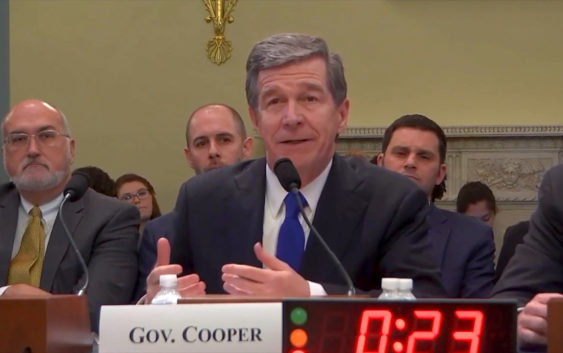- Trump makes more debunked claims about FEMA as he surveys storm damage in North Carolina
- Hundreds rescued, sheriff stranded on truck roof after deadly flooding in New Mexico
- In North Carolina, Trump and Harris navigate a hurricane and a rollercoaster governor’s race
- In North Carolina, Trump and Harris navigate a hurricane and a rollercoaster governor's race
- Family of Tennessee employee who died in Hurricane Helene flooding files wrongful death lawsuit
Three keys to better hurricane recovery

In his address to the U.S. House’s Natural Resources Committee last week, Gov. Roy Cooper made a compelling case for taking a different, more proactive approach to rebuilding after storms, saying, “We spend a lot of money on recovery. Not enough of that money is allowed to be used for mitigation and resiliency.”
With recent hurricanes and storms, all of us in North Carolina have experienced a new normal in rainfall and extreme weather. Hurricane Florence is the most recent, devastating example. As Cooper said in his testimony, “When storms are becoming more destructive, it’s not enough to pick up the pieces. We must take action to prevent this kind of devastation in the future.”
Florence, Matthew, and numerous other unnamed storms have created a call to action and investment in a new approach to recovery that allows communities to bounce forward to a more prosperous, safe, and resilient future. The challenge confronting North Carolina is putting a new, bold recovery plan into action. This plan should have three priorities: 1) protecting vulnerable populations and infrastructure, 2) creating resilient landscapes than can hold water and reduce harm to downstream communities, and 3) ensuring local communities have the resources to develop solutions that make them stronger for the future.
The first priority is protecting human life and infrastructure. The most cost-effective way of reducing loss of property and, in many cases, loss of life, in flood-prone areas is for the state or federal government to implement voluntary buyouts. After Hurricane Floyd, North Carolina invested heavily in buyout programs. We should implement a program of buyouts that protects people, communities, and our rural economy.
Sign Up and Save
Get six months of free digital access to The News & Observer
#ReadLocal
The second priority requires new approaches to mitigate flooding impacts by using natural defenses. We’ve altered nature, removing much of its ability to protect us from storms. Wetlands act as big sponges, absorbing flood waters. Floodplains allow for rivers to spread beyond their banks during high water times. Naturally flowing streams also have the capacity to control flood waters. That’s why restoring and protecting wetlands, floodplains streams and barrier islands are important to helping prevent future disasters such as Florence.
As we move forward, durable solutions to this region’s challenges must come from the people who live in the most affected communities. These are often the people who have been marginalized in the past. Thus, the third priority demands we engage and build the capacity of those residents to help develop inclusive solutions and reduce threats from future environmental disasters.
All of these approaches require new ways of thinking about how our communities live with water. They also require substantial coordination across governments, institutions and stakeholders. North Carolina’s state and federal officials rallied across party lines after the recent storms. We need that same bipartisan action toward investing in planning and sustained capacity to achieve resilience.
The beginning of the next hurricane season is only a few months away. We must act quickly, with new tactics, and on a much larger scale. With bold leadership and a sustained commitment, we are optimistic that North Carolina will emerge from the Hurricane Florence recovery effort stronger and more resilient the next time around.
Hawley Truax is the Southeast regional director of the Environmental Defense Fund. This op-ed also reflects the views of The Nature Conservancy, Audubon North Carolina, Conservation Trust for North Carolina, and American Rivers.